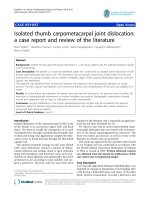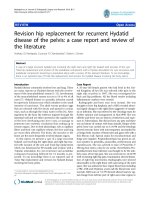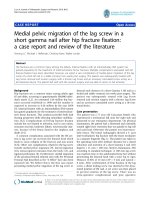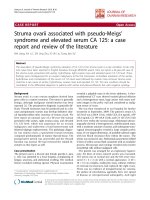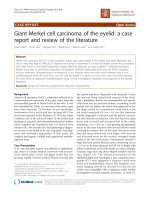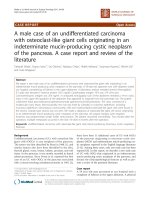báo cáo hóa học:" Low grade fibromyxoid sarcoma: a case report and review of the literature" pot
Bạn đang xem bản rút gọn của tài liệu. Xem và tải ngay bản đầy đủ của tài liệu tại đây (2.18 MB, 7 trang )
CAS E REP O R T Open Access
Low grade fibromyxoid sarcoma: a case report
and review of the literature
Christina Arnaoutoglou
1*†
, Marios G Lykissas
1†
, Ioannis D Gelalis
1†
, Anna Batistatou
2†
, Anna Goussia
2†
,
Michalis Doukas
2†
, Theodoros A Xenakis
1†
Abstract
Low grade fibromyxoid sarcoma (LGFMS) is a distinctive variant of fibrosarcoma with a high metastasizing potential
and sometimes long interval between tumour presentation and metastasis. We present the case of a 50-year-old
male who developed a large mass in the posterior aspect of his lower left thigh. The tumor was excised with pre-
servation of the neurovascular structures surrounded by the mass. The tumour measured 11 × 10 × 9 cm and on
pathology evaluation was diagnosed as LGFMS. Due to the relative rarity of LGFMS, there is no dedicated protocol
regarding follow-up recommendations. In order to early diagnose possible metastasis it is important to inform the
patients about the longst anding metastatic potential of the disease.
Background
Low grade fibromyxoid sarcoma (LGFMS) is a distinc-
tive variant of fibrosarcoma. According t o Evans [1],
who first described this pathologic entity, LGFMS pre-
sents a rare soft-tissue tumour with a high metastasiz-
ing potential, despite the benign histologi c appearance.
The sometimes long interval between tumour presen-
tation and metastasis poses problems for the patholo-
gists, radiologists, and surgeons, with longstanding
follow-up being the fundamental principle for tumour
management.
Although it is a well-described entity it is speculated
that many case s are not diagnosed as LGFMS, so it is
still difficult to estimate its exact incidence. These
tumours usually occur in the proximal extremities and
trunk [2]. S poradically theymaybefoundinunusual
locations, such as the retroperitoneum, head or the
chest wall [2,3]. The majority of LGFMS occur in a sub-
fascial location, but in rare occasions the subcutis or
dermis may be affected [4]. LGFMS typically involves
young or middle-aged adults, but a large number of pae-
diatric cases has also been described [3,5-9].
Herein, we present the case of a 50-year-old male who
developed a large LGFMS on the posterior aspect of his
lower thigh. Imaging depiction, surgical approach of the
mass, and current follow-up recommendations are
discussed.
Case presentation
A 50-year-old male presented with a large tumour on
the posterior aspect of his lower left thigh. The mass
was growing slowly during the past 3 years, but the
patient did not seek for medical treatment until his pre-
sentation in our department. Physical examination
revealed a firm mobile mass without tenderness, redness
or warmth.
Laboratory evaluation and plain radiographs were
unremarkable. A computed tomography (CT) scan with
intravenous administration of contra st material showed
a large, heterogenous, low-density mass (Hounsfield
units measuring between 15 and 50) surrounding the
superficial femoral artery and vein within the Hunter’s
canal as well as the sciatic nerve at the lower thigh.
A mixed density including hypodense and isodense
components was evidence on CT. Magnetic resonance
imaging (MRI) evaluation of the area also demonstrated
a mixed myxoid and fibrous pattern within the tumour.
The fibrous component was identified as hypointense
areas on T1- and T2-weighted MR images and slightly
enhancing on T1-weighted MR images after intravenous
administration of gadolinium (Fig. 1). The myxoid com-
ponent of the mass was recognized as hypointense
on T1-weighted MR images and hyperintense on
T2-weighted MR images, and avidly enhancing on
* Correspondence:
† Contributed equally
1
Department of Orthopaedic Surgery, University of Ioannina School of
Medicine, Ioannina, Greece
Arnaoutoglou et al. Journal of Orthopaedic Surgery and Research 2010, 5:49
/>© 2010 Arnaoutoglou et al; licensee BioMed Central Ltd. This is an Open Access article distributed under the terms of the Creative
Commons Attribution License (http://creativ ecommons.org/licenses/by/2.0), which permits unrestricted use, distribution, and
reproduction in any medium, provided the original work is properly cited.
T1-weighted MR images after gadolinium administration
(Fig. 1).
The patient subsequently underwent a wide biopsy for
additional information, before surgical resection of the
mass. Histological evaluation revealed a moderately cel-
lular lesion consisting of spindle cells with mild atypia
and morphological features of fibroblasts, set in a col-
lagenous stroma. The cells exhibited eosinop hilic cyto-
plasm and vesicular nuclei with, the small nucleoli and
were arranged in a plexiform or whorled pattern.
Mitoses were not found. A very-limited necrotic area
was recognized in the periphe ry of the biopsy specimen.
Immunohistochemically, the neoplastic cells were
positive for vimentin and focally for SMA. Taking into
account the clinical and radiographic findings, malig-
nancy could not be ruled out and a lo w-grade mesench-
ymal neoplasm was suggested.
Seven weeks later the tumor was excised using meti-
culous technique, with preservation of the neurovascular
structures surrounded by the mass. No perforation of
the ve ssels or nerves was evident during mass removal.
The mass was well-circumscribed, but not encapsuled,
making the resection insecure regarding the surgical
margins. A drain was placed 1 cm distal of the periph-
eral end of the surgica l incision. Elaborate hemostasis
and wound closure was followed. After surgery, the
Figure 1 “ T1-weighte d, fat-suppressed, cont rast-enhanced on a sagitta l plane MR image revealed a hyperintense central part and a
hypointense irregular wall corresponding to myxoid and fibrous pattern, respectively.”
Arnaoutoglou et al. Journal of Orthopaedic Surgery and Research 2010, 5:49
/>Page 2 of 7
patient experienced no major complications and was
discharged 5 days later.
The surgical specimen was sent to the Pathology
laboratory. Macroscopically, the tumour measured 11 ×
10 × 9 cm and was partially cover ed by regional muscle
fibers (Fig. 2 ). The surface of the tumor was smooth
and glistering with a light tancolor.Oncutsectionsa
central cystic area filled with partially hemorrhagic, and
partially seromucinous fluid was revealed (Fi g. 3). The
cut surface of the peripheral solid area showed whitish
yellow tissue with focal gelatinous appearance of elastic
consistency. The microscopical evaluation of the mass
revealed a tumor with features similar to those detected
in the preceded biopsy. Additionally, the lesion was
well-circumscribed, characterized by fibrous areas with
increased cellularity and eosinophilic collagen fibers
alternating with less cellular, paler myxoid areas. Char-
acteristically giant rose ttes were noted in the p eriphery
(Fig. 4). The central cystic area corresponded to a
necrotic area. Immunohistochemistry, the neoplastic
cells were consistently positive for vimentin only and
negative for a variety of antibodies. Occasional cells
were positive for SMA. Based on the microscopic fea-
tures, the diagnosis of LGFMS was made.
Following diagnosis, a CT scan of the chest was per-
formed revealing no metastasis to the lung. Postopera-
tively, the patient received radiotherapy consisting of a
total of 60 cGy (2 cGy daily for 30 days), as well as. One
year later the patient is well with no evidence of disease.
Discussion
Low gra de fibromyxoid sarcoma (LGFMS) is a distinc-
tive variant of fibrosarcoma [9]. It is characterized by an
admixture of collagenized hypocellular zones and more
cellular myxoid nodules. Tumour cells are usually small,
with scanty eosinophilic cytoplasm, round to ovoid
nuclei and absent nucleoli. Although focal cytologically
atypical areas of high cellularity, increased mitotic
Figure 2 Gross pathological specimen. The cut section revealed a cystic formation.
Arnaoutoglou et al. Journal of Orthopaedic Surgery and Research 2010, 5:49
/>Page 3 of 7
activity, nuclear h yperchromatism, and necrosis may b e
found in approximately 10% of the cases, tumour cells
are usually cha racterized by absent to sparse mitotic fig-
ures, nuclear anaplasia or necrosis [2]. Immunohisto-
chemical staining is positive for vimentin only and
negative with a variety of antibodies, such as desmin,
keratin, S100 prote in, epithelial membrane antigen,
CD34, and CD31. Muscle specific actin is positive in the
wall of small vessels within the tumor and strongly posi-
tive in the peripheral fibrous layer.
Ten years after the first description of LGFMS by
Evans [1], a similar pathologic entity, the hyalinizing
spindle cell tumor with giant r osettes (HSTGR) was
reported [10]. These tumors are characterized by a
proliferation of bland spindle cells with fibromyxoid
areas that resemble histologically LGFMS. Giant
rosettes which are found in HSTGR is a distinctive
pattern that is defined by the presence of hyalinized
acellular islands surrounded by oval and spindle cells.
In a large series of 77 cases of LGFMS and HSTGR,
Folpe et al. [9] suppo rted that these tumors represent
the same neoplastic process and are of the spectrum of
low-grade sarcomas. According to the same authors,
several cases of LGFMS presented the pattern of min-
iature rosettes that had been overl ooked at t he time o f
the initial diagnoses. On the o ther hand, HSTGR is
typically characterized by large areas that are histologi-
cally identical to LGFMS. Based on these finding the
authors recommended that both entities should be
referred to as “fibrosarcoma, low-grade fibromyxoid
type” noting either the presence or absence of rosettes.
More recently, the view that these two entities share
the same pathologic mechanism was strongly sup-
ported by several investigators.Morespecifically,the
presence of a balanced t(7;16)(q34;p11) translocation
and a fusion betw een the FUS and CREB3L2 genes in
both LGFMS and HSTGR were confirmed by multiple
studies[11-16].Thistranslocationseemstobespecific
for the diagnosis of these tumors and particularly use-
ful in cases of limited material for examination or in
cases that the typical histopathologic features are not
present. Furthermore, the FUS/CREB3L1 fusion tran-
scripts of LGFMS can be reliably detected in paraffin-
embedded tissues using R T-PCR [17].
Differential diagnosis of LGFMS includes lesions
showing spindle cell proliferations with myxoid pattern
with or without fibrous component [4]. The entities
with predominantly myxoid pattern without significant
fibrous component include myxomas, low-grade myxofi-
brosarcoma, angiomyxomas, myxoid liposarcoma, and
myxoid neurofibroma. Tumors with mixed myxoid and
fibrous morphologies include neurofibroma, f ibromato-
sis, perineurioma, malignant peripheral sheath tumor,
and fibrous histiocytoma. Additional entities that should
be encountered are desmoid tumor, desmoplastic fibro-
sarcoma, and low grade dedifferentiated liposarcoma.
The diagnosis of LGFMS or HSTGR is usually not dif-
ficult if the t umor has been removed completely and all
Figure 3 Gross section demonstrated the intermixed fibrous and myxoid components.
Arnaoutoglou et al. Journal of Orthopaedic Surgery and Research 2010, 5:49
/>Page 4 of 7
the characteristic morphologic and immunophenotypic
feat ures described above are present. This is not usually
feasible when the material derives from fine needle
aspiration or needle core biopsy [4]. In such cases, a
wider biopsy, as in our case, or even an excisional
biopsy should be performed. If a myxoid pattern is pre-
sent and the diagnosis still remains unclear, cytogenetics
should be requested in order to exclude the rare case of
LGFMS [4].
The clinical presentation is usually long-standing and
is mainly related to the anatomic location of the mass.
LGFMS usually presents as a painless soft-tissue mass
with a pre-biopsy duration of over 5 years in 15% of
patients [2]. In rare occasions acute presentations of the
disease may occur, such as acute respiratory distress and
chest pain in case of chest wall LGFMS or seizure activ-
ity in a patient with intracranial LGFMS [3,18].
Although imaging findings o f LGFMS are nonspecific,
certain CT and MRI findings have been described
[3,19-21]. On noncontrast CT images the fibrous com-
ponent of these tumors has been described as isodense
to muscle tissue and the myxoid component as hypo-
dense. On MR imaging, the fibrous component is char-
acterized as hypointense on T1- and T2-weighted MR
images, and slightly enhancing on T1-weighted MR
images after gadol inium administration. On the other
hand, the myxoid component has been described as
hypointense on T1-weighted MR images and hyperin-
tense on T2-weighted MR images, and vividly enhancing
on T1-weighted MR images after gadolinium adminis-
tration. Calcifications may also be found within the
tumor [21].
Evans [6] and Goodlad et al. [8] suggested that
LGFMS were paradoxically aggressive tumors. In these
retrospective early series, local recurre nce was noted in
68%, metastasis in 41%, and death from disease in 18%
[2]. Almost all these patients in these original studies
were initially diagnosed with, and treated for a benign
lesion . It is obvious that patient selection has influenced
the reported rate of recurrence and metastases, as many
of those cases were selected on the base of unexplained
metastases. In a more recent and larger series local
Figure 4 Giant rosettes with hyallinized central collagen surrounded by plump to oval cells.
Arnaoutoglou et al. Journal of Orthopaedic Surgery and Research 2010, 5:49
/>Page 5 of 7
recurrence, metastasis, and death from disease was
observed in 54%, 6%, and 2% of the patients, respectively
[9]. In the s ame study it has been shown that the pre-
sence of focal areas of high cellularity, nuclear enlarge-
men t, increased mitotic activity, and necrosis are not of
prognostic significance for recurrence or metastasis.
Given the potential of LGFMS for late metastasis, some-
times 45 years after initial diagnosis, the median follow-
up of only 24 months in the previous s tudy should be
considered too short in order to ascertain safe conclu-
sions [4].
Once the diagnosis of LGFMS or HSTGR is made, a
full oncological assessment should follow. This should
include a CT scan of the chest, since metastasis to the
lung is the most comm on scenario. B ecause of the high
risk of late metastasis, clinical follow-up and chest ima-
ging should be performed for an extended period of
time. However, it is still unclear how regularly imaging
of the chest should be repeated [4].
Conclusions
The case report presented herein, enriches the literature
withinformationonimaging diagnosis and surgical
treatment of this rare tumor. As there is no dedicated
protocol regarding follow-up examinations and in order
to early diagnose possible metastasis it is important to
inform the patients about the longstanding metastatic
potential of the disease.
Consent
Written informed consent was obtained from the patient
for publication of this case report and any accompany-
ing images. A copy of the written consent is available
for review by the Editor-in-Chief of this journal.
Author details
1
Department of Orthopaedic Surgery, University of Ioannina School of
Medicine, Ioannina, Greece.
2
Department of Pathology, University of Ioannina
School of Medicine, Ioannina, Greece.
Authors’ contributions
All authors contributed equally to this work. MGL, CA and MD participated
in the design of the study and drafted the manuscript. IDG and AG
participated in the design of the study. TAX and AB conceived of the study,
and participated in its design and coordination and helped to draft the
manuscript
MGL has had the main responsibility for the study and manuscript
preparation. All authors read and approved the final manuscript.
Competing interests
There are no competing interests; this is a basic academic research initiative.
Received: 17 January 2010 Accepted: 29 July 2010
Published: 29 July 2010
References
1. Evans HL: Low-grade fibromyxoid sarcoma. A report of two
metastasizing neoplasms having a deceptively benign appearance. Am J
Clin Pathol 1987, 88:615-9.
2. Folpe A, van den Berg E, Molenaar WM: Low grade fibromyxoid sarcoma.
World Health Organization Classification of Tumours. Pathology and Genetics
of Tumours of Soft Tissue and Bone Lyon: IARC PressFletcher CDM, Unni KK,
Mertens F 2002, 104-105.
3. Steiner MA, Giles HW, Daley WP: Massive low-grade fibromyxoid sarcoma
presenting as acute respiratory distress in a 12-year-old girl. Pediatr
Radiol 2009, 39:396-9.
4. Wu X, Petrovic V, Torode IP, Chow CW: Low grade fibromyxoid sarcoma:
problems in the diagnosis and management of a malignant tumour
with bland histological appearance. Pathology 2009, 41:155-60.
5. Canpolat C, Evans HL, Corpron C, Andrassy RJ, Chan K, Eifel P, Elidemir O,
Raney B: Fibromyxoid sarcoma in a four-year-old child: case report and
review of the literature. Med Pediatr Oncol 1996, 27:561-4.
6. Evans HL: Low-grade fibromyxoid sarcoma. A report of 12 cases. Am J
Surg Pathol 1993, 17:595-600.
7. Fukunaga M, Ushigome S, Fukunaga N: Low-grade fibromyxoid sarcoma.
Virchows Arch 1996, 429:301-3.
8. Goodlad JR, Mentzel T, Fletcher CD: Low grade fibromyxoid sarcoma:
clinicopathological analysis of eleven new cases in support of a distinct
entity. Histopathology 1995, 26:229-3.
9. Folpe AL, Lane KL, Paull G, Weiss SW: Low-grade fibromyxoid sarcoma
and hyalinizing spindle cell tumor with giant rosettes: a
clinicopathologic study of 73 cases supporting their identity and
assessing the impact of high-grade areas. Am J Surg Pathol 2000,
24:1353-60.
10. Lane KL, Shannon RJ, Weiss SW: Hyalinizing spindle cell tumor with giant
rosettes: a distinctive tumor closely resembling lowgrade fibromyxoid
sarcoma. Am J Surg Pathol 1997, 21:1481-8.
11. Bejarano PA, Padhya TA, Smith R, Blough R, Devitt JJ, Gluckman JL:
Hyalinizing spindle cell tumor with giant rosettes–a soft tissue tumor
with mesenchymal and neuroendocrine features: an
immunohistochemical, ultrastructural, and cytogenetic analysis. Arch
Pathol Lab Med 2000, 124:1179-84.
12. Panagopoulos I, Storlazzi CT, Fletcher CD, Fletcher JA, Nascimento A,
Domanski HA, Wejde J, Brosjö O, Rydholm A, Isaksson M, Mandahl N,
Mertens F: The chimeric FUS/CREB3L2 gene is specific for low-grade
fibromyxoid sarcoma. Genes Chromosomes Cancer 2004, 40:218-28.
13. Storlazzi CT, Mertens F, Nascimento A, Isaksson M, Wejde J, Brosjo O,
Mandahl N, Panagopoulos I: Fusion of the FUS and BBF2H7 genes in low
grade fibromyxoid sarcoma. Hum Mol Genet 2003, 12:2349-58.
14. Reid R, de Silva MV, Paterson L, Ryan E, Fisher C: Low-grade fibromyxoid
sarcoma and hyalinizing spindle cell tumor with giant rosettes share a
common t(7;16)(q34;p11) translocation. Am J Surg Pathol
2003,
27:1229-36.
15. Mertens F, Fletcher CDM, Antonescu CR, Coindre JM, Colecchia M,
Domanski HA, Downs-Kelly E, Fisher C, Goldblum JR, Guillou L, Reid R,
Rosai J, Sciot R, Mandahl N, Panagopoulos I: Clinicopathologic and
molecular genetic characterization of low-grade fibromyxoid sarcoma,
and cloning of a novel FUS/CREB3L1 fusion gene. Lab Invest 2005,
85:408-15.
16. Matsuyama A, Hisaoka M, Shimajiri S, Hayashi T, Imamura T, Ishida T,
Fukunaga M, Fukuhara T, Minato H, Nakajima T, Yonezawa S, Kuroda M,
Yamasaki F, Toyoshima S, Hashimoto H: Molecular detection of FUS-
CREB3L2 fusion transcripts in low-grade fibromyxoid sarcoma using
formalin-fixed, paraffin-embedded tissue specimens. Am J Surg Pathol
2006, 30:1077-84.
17. Guillou L, Benhattar J, Gengler C, Gallagher G, Ranchère-Vince D, Collin F,
Terrier P, Terrier-Lacombe MJ, Leroux A, Marquès B, Aubain Somerhausen
Nde S, Keslair F, Pedeutour F, Coindre JM: Translocation-positive low
grade fibromyxoid sarcoma: clinicopathologic and molecular analysis of
a series expanding the morphologic spectrum and suggesting potential
relationship to sclerosing epithelioid fibrosarcoma. Am J Surg Pathol
2007, 31:1387-402.
18. Saito R, Kumabe T, Watanabe M: Low-grade fibromyxoid sarcoma of
intracranial origin. J Neurosurg 2008, 108 :798-802.
19. Kim SY, Kim M, Hwang YJ, Han YH, Seo JW, Kim YH, Cha SJ, Hur G: Low-
grade fibromyxoid sarcoma CT, sonography, and MR findings in 3 cases.
J Thorac Imaging 2005, 20:294-7.
20. Fujii S, Kawawa Y, Horiguchi S, Kamata N, Kinoshita T, Ogawa T: Low-grade
fibromyxoid sarcoma of the small bowel mesentery: computed
Arnaoutoglou et al. Journal of Orthopaedic Surgery and Research 2010, 5:49
/>Page 6 of 7
tomography and magnetic resonance imaging findings. Radiat Med 2008,
26:244-7.
21. Miyake M, Tateishi U, Maeda T, Arai Y, Seki K, Hasegawa T, Sugimura K: CT
and MRI features of low-grade fibromyxoid sarcoma in the shoulder of a
pediatric patient. Radiat Med 2006, 24:511-4.
doi:10.1186/1749-799X-5-49
Cite this article as: Arnaoutoglou et al.: Low grade fibromyxoid sarcoma:
a case report and review of the literature. Journal of Orthopaedic Surgery
and Research 2010 5:49.
Submit your next manuscript to BioMed Central
and take full advantage of:
• Convenient online submission
• Thorough peer review
• No space constraints or color figure charges
• Immediate publication on acceptance
• Inclusion in PubMed, CAS, Scopus and Google Scholar
• Research which is freely available for redistribution
Submit your manuscript at
www.biomedcentral.com/submit
Arnaoutoglou et al. Journal of Orthopaedic Surgery and Research 2010, 5:49
/>Page 7 of 7
